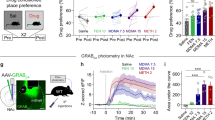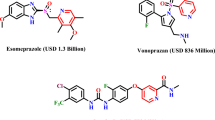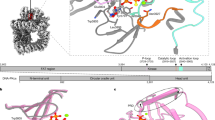Abstract
3,4-methylenedioxymethamphetamine (MDMA or Ecstasy) is a substituted amphetamine whose acute and long-term effects on the serotonin system are dependent on an interaction with the 5-HT uptake transporter (SERT). Although much of the work dedicated to the study of this compound has focused on its ability to release monoamines, this drug has many important metabolic consequences on neurons and glial cells. The identification of these physiological responses will help to bridge the gap that exists in the information between the acute and neurotoxic effects of amphetamines. Substituted amphetamines have the ability to produce a long-term translocation of protein kinase C (PKC) in vivo, and this action may be crucial to the development of serotonergic neurotoxicity. Our earlier results suggested that PKC activation occurred through pre- and postsynaptic mechanisms. Because the primary site of action of these drugs is the 5-HT transporter, we now expand on our previous results and attempt to characterize MDMA's ability to translocate PKC within cortical 5-HT nerve terminals. In synaptosomes, MDMA produced a concentration-dependent increase in membrane-bound PKC (as measured by 3H-phorbol 12, 13 dibutyrate, 3H-PDBu) bindings sites. This response was abolished by cotreatment with the specific serotonin reuptake inhibitor (SSRI), fluoxetine, but not by the 5-HT2A/2C antagonist, ketanserin. In contrast, full agonists to 5-HT1A and 5-HT2 receptors did not produce significant PKC translocation. MDMA-mediated PKC translocation also requires the presence of extracellular calcium ions. Using assay conditions where extracellular calcium was absent prevented the in vitro activation of PKC by MDMA. Prolonged PKC translocation has been hypothesized to contribute to the calcium-dependent neurotoxicity produced by substituted amphetamines. In addition, many physiological processes within 5-HT nerve terminals, including 5-HT reuptake and vesicular serotonin release, are susceptible to modification by PKC-dependent protein phosphorylation. Our results suggest that prolonged activation of PKC within the 5-HT nerve terminal may contribute to lasting changes in the homeostatic function of 5-HT neurons, leading to the degeneration of specific cellular elements after repeated MDMA exposure.
Similar content being viewed by others
Log in or create a free account to read this content
Gain free access to this article, as well as selected content from this journal and more on nature.com
or
References
Appel NM, Contrera J, DeSouza EB . (1989): Fenfluramine selectively and differentially decreases the density of serotonergic nerve terminals in rat brain: Evidence from immunocytochemical studies. J Pharamacol Exp Ther 249: 928–943
Azmitia EC, Murphy RB, Whitaker-Azmitia PM . (1990): MDMA (Ecstasy) effects on cultured serotonergic neurons: Evidence for Ca2+-dependent toxicity linked to release. Brain Res 510: 97–103
Azmitia EC, Kramer HK, Kim-Park WK . (1993): Nimodipine blocks the efflux of 45Ca2+ and enhances the depolarization-induced release of 3H-5-HT from CNS synaptosomes. In Scriabine A, Janis RA, Triggle DJ (eds), Drugs in Development. Branford, CT, Neva Press, pp 437–446
Battaglia G, Brooks BP, Kulsakdinun C, DeSouza EB . (1988a): Pharmacological profile of MDMA (3,4-methylenedioxymethamphetamine) at various brain recognition sites. Eur J Pharmacol—Mol Pharm Sec 149: 159–163
Battaglia G, Yeh EB, DeSouza E . (1988b): MDMA-induced neurotoxicity: Parameters of degeneration and recovery of brain serotonin neurons. Pharmacol Biochem Behav 29: 269–274
Benowitz LI, Perrone-Bizzozero NI, Finklestein SP . (1987): Molecular properties of the growth-associated protein GAP-43 (B-50). J Neurochem 48: 1640–1647
Berger UV, Grzanna R, Molliver ME . (1992a): The neurotoxic effects of p-chloroamphetamine in rat brain are blocked by prior depletion of serotonin. Brain Res 578: 177–185
Berger UV, Gu XF, Azmitia EC . (1992b): The substituted amphetamines 3,4-methylenedioxymethamphetamine, methamphetamine, p-chloroamphetamine and fenfluramine induce 5-hydroxytryptamine release via a common mechanism blocked by fluoxetine and cocaine. Eur J Pharmacol—Mol Pharm Sec 215: 153–160
Blue ME, Yagaloff KA, Mamounas LA, Hartig PR, Molliver ME . (1988): Correspondence between 5-HT2 receptors and serotonergic axons in rat neocortex. Brain Res 453: 315–328
Commins DL, Vosmer G, Virus RM, Wollverton WL, Schuster CR, Seiden LS . (1987): Biochemical and histological evidence that methylenedioxymethamphetamine (MDMA) is toxic to the rat brain. J Pharmacol Exp Ther 241: 338–345
Conn PJ, Sanders-Bush E . (1985): Serotonin-simulated phosphoinositide turnover: Mediation by the S2 binding site in rat cerebral cortex but not in subcortical regions. J Pharmacol Exp Ther 234: 195–203
Conn PJ, Sanders-Bush E . (1986): Regulation of serotonin-stimulated phosphoinositide hydrolysis: Relation to the serotonin 5-HT2 binding site. J Neurosci 6: 3669–3675
Farfel GM, Vosmer GL, Seiden LS . (1992): The N-methyl-D-asparate antagonist MK-801 protects against serotonin depletions induced by methamphetamine, 3,4-methylenedioxymethamphetamine and p-chloroamphetamine. Brain Res 595: 121–128
Fischer C, Hatzidimitriou G, Wlos J, Katz J, Ricaurte G . (1995): Reorganization of ascending 5-HT axon projections in animals previously exposed to the recreational drug 3,4-methylenedioxymethamphetamine (MDMA, “Ecstasy”). J Neurosci 15: 5476–5485
Fischette CT, Nock B, Renner K . (1987): Effects of 5,7-DHT on serotonin{-1} and serotonin{-2} receptors throughout the rat central nervous system using quantitative autoradiography. Brain Res 421: 263–279
Gandhi VC, Jones DJ . (1991): G-protein modulation of 3H-serotonin release through the L-type calcium channel. Ann NY Acad Sci 635: 455–458
Giambalvo CT . (1992a): Protein kinase C and dopamine transport—1. Effects of amphetamine in vivo. Neuropharmacology 31: 1201–1210.
Giambalvo CT . (1992b): Protein kinase C and dopamine transport—2. Effects of amphetamine in vitro. Neuropharmacology 31: 1211–1222
Gott AL, Mallon BS, Paton A, Groome N, Rumsby MG . (1994): Rat brain glial cells in primary culture and subculture contain the delta, epsilon, and zeta subspecies of protein kinase C as well as the conventional subspecies. Neurosci Lett 171: 117–120
Gu XF, Azmitia EC . (1993): Integrative transporter-mediated releases from cytoplasmic and vesicular 5-hydroxytryptamine stores in cultured neurons. Eur J Pharmacol—Mol Pharm Sec 235: 51–57
Harrington MA, Shaw K, Zhong P, Ciaranello RD . (1994): Agonist-induced desensitization and loss of high-affinity binding sites of stably expressed human 5-HT1A receptors. J Pharmacol Exp Ther 268: 1098–1106
Hekmatpanah CR, Peroutka SJ . (1990): 5-hydroxytryptamine uptake blockers attenuate the 5-hydroxytryptamine-releasing effect of 3,4-methyldioxymethamphetamine and related agents. Eur J Pharmacol—Mol Pharm Sec 177: 95–98
Hirst WD, Rattray MAN, Price GW, Wilkin GP . (1994): Expression of 5-HT1A, 5-HT2A, and 5-HT2C receptors on astrocytes. Soc Neurosci Abstr 20: 1547
Insel TR, Battaglia G, Johannessen JN, Marra S, DeSouza EB . (1989): 3,4-methylenedioxymethamphetamine (“Ecstasy”) selectively destroys brain serotonin terminals in rhesus monkeys. J Pharmacol Exp Ther 249: 713–720
Johnson MP, Conarty PF, Nichols DE . (1991): 3H-Monoamine releasing and inhibition properties of 3,4-methylenedioxymethamphetamine and p-chloroamphetamine analogues. Eur J Pharmacol—Mol Pharm Sec 200: 9–16
Johnson MP, Hoffman AJ, Nichols DE . (1986): Effects of the enantiomers of MDA, MDMA, and related analogues on 3H-serotonin and 3H-dopamine release from the superfused rat brain slices. Eur J Pharmacol—Mol Pharm Sec 132: 269–276
Kagaya A, Mikuni M, Kusumi I, Yamamoto H, Takahashi K . (1990): Serotonin-induced acute desensitization of serotonin 2 receptors in human platelets via a mechanism involving protein kinase C. J Pharmacol Exp Ther 255: 305–311
Kokotos Leonardi ET, Azmitia EC . (1994): MDMA (Ecstasy) inhibition of MAO type A and type B: Comparisons with fenfluramine and fluoxetine (Prozac). Neuropsychopharmacology 10: 231–238
Kramer HK, Azmitia EC . (1994): Is protein kinase C activation a key step in MDMA-induced toxicity of serotonergic neurons? CPDD Abstract 144: 273
Kramer HK, Poblete JC, Azmitia EC . (1995): 3,4-methylenedioxymethamphetamine (“Ecstasy”) promotes the translocation of protein kinase C (PKS): Requirement of viable serotonin nerve terminals. Brain Res 680: 1–8
Kramer HK, Poblete JC, Azmitia EC . (1997): The activation of protein kinase C by 3,4-methylenedioxymethamphetamine (MDMA) occurs through stimulation of serotonin receptors and transporter. Neuropsychopharmacology 17: 117–129
Lowry OH, Rosenbrough NJ, Farr AL, Randall RJ . (1951): Protein measurement with the Folin phenol reagent. J Biol Chem 193: 265–275
Mahoney CW, Huang KP . (1995): Selective phosphorylation of cationic polypeptide aggregates with phosphotidylserine/diacylglcerol/Ca2+/detergent mixed micelles by Ca2+-independent but no Ca2+-dependent protein kinase C isozymes. Biochemistry 34: 3446–3454
Malberg JE, Malis RW, Sabol KE, Seiden LS . (1994): Both ketanserin and alpha-methyl-para-tyrosine may protect against MDMA neurotoxicity by producing a hypothermic response in the rat. CPDD Abstract 56: 213
Mamounas LA, Molliver ME . (1988): Evidence for dual serotonergic projections to neocortex: Axons from the dorsal and median raphe are differentially viable to the neurotoxin p-chloroamphetamine. Exp Neurol 102: 23–36
Manev H, Costa E, Wroblewski JT, Guidotti A . (1990): Abusive stimulation of excitatory amino acid receptors: A strategy to limit neurotoxicity. Fed Am Soc Exper Biol 4: 2789–2797
Manev H, Favaron M, Alho H, Bertolino M, Guidotti A, Costa E . (1988): Gangliosides and NMDA-sensitive glutamate receptor antagonists prevent glutamate neurotoxicity via different mechanisms. Soc Neurosci Abstr 14: 747
Manev H, Favaron M, Guidotti A, Costa E . (1989): Delayed increase of Ca2+ influx elicited by glutamate: Role in neuronal death. Mol Pharmacol 36: 106–112
Masliah E, Yoshida K, Shimahama S, Gage Fh, Saitosh T . (1991): Differential expression of protein kinase C isozymes in rat glial cell cultures. Brain Res 549: 106–111
Meller E, Bohmaker K, Goldstein M, Friedhoff A . (1985): Inactivation of D1 and D2 dopamine receptors by N-ethoxycarbonyl-2-ethoxy-1,2-dihydroquinoline in vivo: Selective protection by neuroleptics. J Pharmacol Exp Ther 233: 656–662
Melloni E, Pontremolli S, Michetti M, Sacco O, Sparatore B, Salamino F, Horrecker BL . (1985): Binding of protein kinase C to neutrophil membranes in the presence of Ca2+ and its activation by a Ca2+-requiring proteinase. Proc Natl Acad Sci 82: 6435–6439
Miller KJ, Hoffman BJ . (1994): Adenosine A3 receptors regulate serotonin transport via nitric oxide and cGMP. J Biol Chem 269: 27351–27356
Munson PJ, Rodbard D . (1980): Ligand: A versatile computerized approach for characterization of ligand binding systems. Analyt Biochem 107: 220–239
Nash JF . (1990): Ketanserin pretreatment attenuates MDMA-induced dopamine release in the striatum as measured by in vivo microdialysis. Life Sci 47: 2401–2408
Nichols DE, Lloyd DH, Hoffman AJ, Nichols MB, Yim GK . (1982): Effects of certain hallucinogenic amphetamine analogues on the release of 3H-serotonin from rat brain synaptosomes. J Med Chem 25: 530–535
O'Hearn E, Battaglia G, DeSouza EB, Kuhar MJ, Molliver ME . (1988): Methylenedioxyamphetamine (MDA) and methylenedioxymethamphetamine (MDMA) cause selective ablation of serotonin axon terminals in forebrain: Immunocytochemical evidence for neurotoxicity. J Neurosci 8: 2788–2803
Park WP, Azmitia EC . (1991): 5-HT, MDMA (Ecstasy), and nimodipine effects of 45Ca2+-uptake into rat brain synaptosomes. Ann NY Acad Sci 635: 438–442
Pierce PA, Peroutka SJ . (1988): Ring-substituted amphetamine interactions with neurotransmitter receptor binding sites in human cortex. Neurosci Lett 95: 208–212
Poblete JCP, Azmitia EC . (1995): Activation of glycogen phosphorylase by 3,4-methylenedioxymethamphetamine in astrocyte-rich primary glial cultures: Role of the 5-HT2A receptor. Brain Res 680: 9–16
Pu C, Vorhees CV . (1995): Protective effects of MK-801 on methamphetamine-induced depletion of dopaminergic and serotonergic terminals and striatal astrocytic response: An immunohistochemical study. Synapse 19: 97–104
Qian Y, Galli A, Ramamoorthy S, Risso S, DeFelice I, Blakely RD . (1997): Protein kinase C activation regulates human serotonin transporters in HEK-293 cells via altered cell surface expression. J Neurosci 17: 45–57
Quik M, Azmitia E . (1983): Selective destruction of the serotonergic fibers of the fornix-fimbria and cingulum bundle increases 5-HT, but not 5-HT-2 receptors in rat midbrain. Eur J Pharmacol—Mol Pharm Sec 90: 377–384
Ricaurte GA, DeLanney LE, Weiner SG, Langston JW . (1988): Toxic effect of MDMA on central serotonergic neurons in the primate: Importance of route and frequency of drug administration. Brain Res 446: 165–168
Rudnick G, Wall SC . (1992a): p-chloroamphetamine induces serotonin release through serotonin transporters. Biochemistry 31: 6710–6718
Rudnick G, Wall SC . (1992b): The molecular mechanisms of “ecstasy” [3,4-methylenedioxymethamphetamine (MDMA)]: Serotonin transporters are targets for MDMA-induced serotonin release. Proc Natl Acad Sci 89: 1817–1821
Sanders-Bush E, Strenaka LR . (1978): Immediate and long-term effects of p-chloroamphetamine on brain amines. Ann NY Acad Sci 305: 208–221
Schmidt CJ . (1987): Neurotoxicity of the psychedelic amphetamine, methylenedioxymethamphetamine. J Pharmacol Exp Ther 240: 1–7
Schmidt CJ, Levin TA, Lovenberg W . (1987): In vitro and in vivo neurochemical effects of methylenedioxymethamphetamine on striatal monoaminergic systems in the rat brain. Biochem Pharmacol 36: 747–755
Schmidt CJ, Black CK, Abbate GM, Taylor VL . (1990): Methylenedioxymethamphetamine-induced hyperthermia and neurotoxicity are independently mediated by 5-HT2 receptors. Brain Res 529: 85–90
Schmidt CJ, Taylor VL, Abbate GM, Nieduzak TR . (1991): 5-HT-2 antagonists stereoselectively prevent the neurotoxicity of 3,4-methylenedioxymethamphetamine by blocking the acute stimulation of dopamine synthesis: reversal by L-dopa. J Pharmacol Exp Ther 256: 230–235
Schmidt CJ, Black CK, Taylor VT, Fadayel GM, Humphreys TM, Nieduzak TR, Sorensen SM . (1992): The 5-HT2 receptor antagonist, MDL 28, 133A, disrupts the serotonergic-dopaminergic interaction mediating the neurochemical effects of 3,4-methylenedioxymethamphetamine. Eur J Pharmacol—Mol Pharm Sec 220: 151–159
Steele TD, Nichols DE, Yim GKW . (1987): Stereochemical effects of 3,4-methylenedioxymethamphetamine (MDMA) and related amphetamine derivatives on inhibition of uptake of 3H-monoamines into synaptosomes of different regions of rat brain. Biochem Pharmacol 36: 2297–2303
Suda N, Franzius D, Fleig A, Nishimura S, Bodding M, Hoth M, Takeshima H, Penner R . (1997): Ca2+ induced Ca2+ release in Chinese hamster ovary (CHO) cells co-expressing dihydropyridine and ryanodine receptors. J Gen Physiol 109: 619–631
Takagishi Y, Rothery S, Issberner J, Levi A, Severs NJ . (1997): Spatial distribution of dehydropyridine receptors in the plasma membrane of guinea pig cardiac myocytes investigated by correlative confocal microscopy and label-fracture electron microscopy. J Electron Micros 46: 165–170
Wang H-Y, Friedman E . (1990): Central 5-hydroxytryptamine receptor-linked protein kinase C translocation: A functional postsynaptic signal transduction system. Mol Pharmacol 37: 75–79
Zhang L, Coffey LL, Reith MEA . (1997): Regulation of the functional activity of the human dopamine transporter of protein kinase C. Biochem Pharmacol 53: 677–688
Acknowledgements
The authors gratefully acknowledge the contribution to Dr. Patricia M. Whitaker-Azmitia, Dr. Nancy Kheck, Dr. Xiao Ping Hou, and Lauren Kramer toward the completion of this manuscript.
Author information
Authors and Affiliations
Rights and permissions
About this article
Cite this article
Kramer, H., Poblete, J. & Azmitia, E. Characterization of the Translocation of Protein Kinase C (PKC) by 3,4-methylenedioxymethamphetamine (MDMA/Ecstasy) in Synaptosomes: Evidence for a Presynaptic Localization Involving the Serotonin Transporter (SERT). Neuropsychopharmacol 19, 265–277 (1998). https://doi.org/10.1016/S0893-133X(98)00027-X
Received:
Revised:
Accepted:
Issue date:
DOI: https://doi.org/10.1016/S0893-133X(98)00027-X



